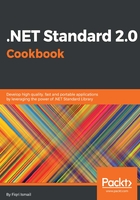
Introduction
Microsoft .NET is a general-purpose development platform with support for multiple programming languages, which is a key feature. Other key features include asynchronous and concurrent programming models and native interoperability. The .NET Framework supports multiple programming languages, such as C#, VB.NET, and F#, which are actively developed and supported by Microsoft. In this book, we are going to look at C#.
C# is a modern, object-oriented, type-safe programming language that helps developers build robust, secure applications using the .NET Framework. C# was introduced with .NET Framework 1.0 in 2002. Since that time, C# has evolved and matured. At the time of writing, the current version of C# is 7.0 and .NET has various flavors to use with the following:
- .NET Framework: The full flavor of .NET that is distributed with Windows. Used by developers to build ASP.NET 4.5/4.6 under Windows or desktop Windows applications.
- .NET Core: Another flavor of .NET that runs under Windows, Mac, and Linux. Used by developers to build cross-platform .NET-based applications including cross-platform web applications, using ASP.NET Core.
- Xamarin: A mono-based framework used for mobile applications for iOS, Android, and Windows phone devices. macOS desktop applications are supported with this flavor.
- .NET Standard: A replacement for Portable Class Libraries (PCL) used by developers to share code among all platforms, but supported with APIs in the latest version, 2.0. Also, you should note that .NET Standard 2.0 is supported in .NET Core 2.0, .NET Framework 4.6.1, and later versions, as well as in Visual Studio 2017 (version 15.3).